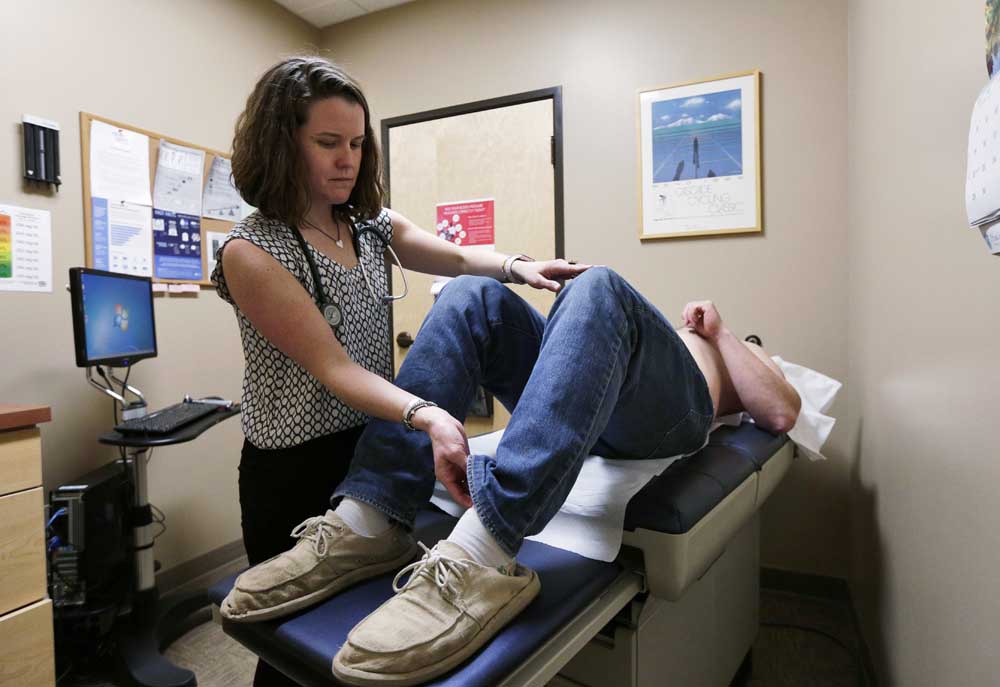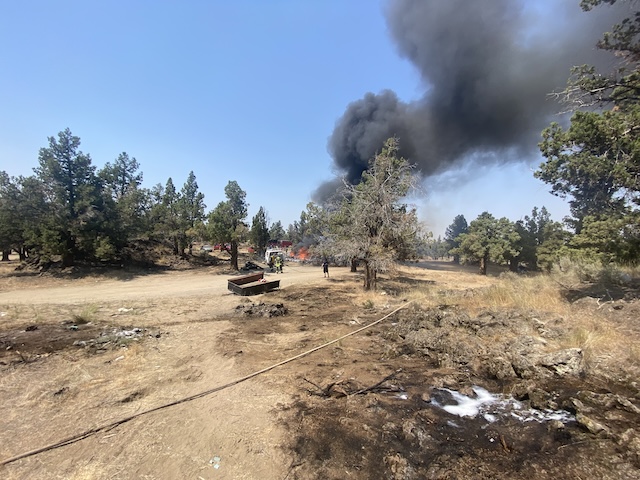Does it have to be a doctor?
Published 12:00 am Sunday, April 15, 2018

- Physician assistant Whitney Drew examines Corey Underhill during an office visit at High Lakes Health Care in Bend. (Joe Kline/Bulletin photo)
Despite more than 40 years of experience with nurse practitioners and physician assistants in Oregon, the health care system still can’t quite figure out what to do with them.
Originally intended to increase access to care in underserved rural communities, these advanced practice providers, as they are called, have become an integral part of even the most urban health care systems.
Trending
Yet, questions remain about their role, their quality of care and how best to deploy them in a health system facing increasing cost pressure and workforce challenges.
Those tensions have come to a head in Central Oregon, where many nurse practitioners and physician assistants are concerned their contributions are being undervalued. At the same time, patients often feel confused about when they should see a physician or when an advanced practice provider will do.
“I think the whole country is still figuring out what’s the best role for these people and how much of a doctor’s job really needs medical school,” said Dr. Gillian Salton, an emergency room physician and chief of the medical staff at St. Charles Bend. “And I don’t know that anybody has answered that to our satisfaction.”
Advance practice providers in the region are particularly concerned about a recent decision by St. Charles Medical Group, the organization that staffs the four St. Charles Health System hospitals, to lay off four advanced practice providers, but no physicians, from its hospitalist group. Hospitalists provide care solely to patients in the hospital.
“The layoffs are purely a response to economic pressures,” said Dr. Laura Pennavaria, chief medical officer of the St. Charles Medical Group.
The need to eliminate some positions within the hospitalist group, she said, prompted officials to evaluate their staffing model. St. Charles officials ultimately decided to shift to a model with more physicians and fewer advanced practice providers, even though nurse practitioners and physician assistants are paid less than physicians.
Trending
But Pennavaria cautioned the change should not be seen as a move away from advanced practice providers across the health system.
“Health care delivery is constantly evolving, and as it evolves, we are constantly reassessing our staffing model in any given specialty,” she said. “At times, the balance of physicians to advanced practice providers will shift one way or another.”
While they reduced the numbers of advanced practice providers in the hospitalist group, the medical group is adding them in its palliative care and trauma programs.
“Physicians and advanced practice providers both play essential roles, but their roles are not identical. They’re not interchangeable,” Pennavaria said.
Still many advanced practice providers in Central Oregon feel a strong bias against them within the local health community.
“I think it’s a changing environment. In the last couple of years, it’s dramatically improved,” said Joel Swift, a nurse anesthetist in Bend. “But Oregon is still behind the times when it comes to the role of the advanced practice provider across the board.”
Comparing roles
Nurse practitioners and physician assistants generally complete six to eight years of medical education before seeing patients. Most physicians undergo a minimum of 11 years of education, with additional years required for some specialties.
While nurse practitioners are licensed and trained to practice independently, physician assistants work under the supervision of a physician. Supervising physicians are required to review a certain number of the physician assistant’s cases, a higher number earlier in their careers, fewer as they become more experienced.
How much that difference in education affects the quality of care has been a longstanding point of debate. Studies comparing the care of advanced practice providers and doctors generally find little difference in quality for the vast majority of conditions seen in a medical setting. Researchers from George Washington University, for example, recently compared the care of nurse practitioners, physician assistants and doctors in community health clinics.
“The patients who saw nurse practitioners or saw physician assistants largely got the same care as patients who saw physicians,” said Ellen Kurtzman, a nursing professor and the lead author of the study.
But Kurtzman said researchers are constrained by the type of data they can use in making such comparisons. There are only a limited number of quality measures that the industry has agreed on, generally focusing on the most common conditions.
“Some of the conditions that are of interest are just infrequent enough that when the sample is small and the condition is infrequent, you just don’t have enough cases to make any observation or draw any conclusion,” Kurtzman said.
That raises the question of whether advanced practice providers do just as well diagnosing and treating less common conditions. And many patients sometimes wonder whether a physician assistant or a nurse practitioner might miss something that a doctor would pick up. And that’s been an area that has been much harder to study.
“We, to my knowledge, have not assessed the diagnostic accuracy of nurse practitioners versus physicians, both for common and uncommon illnesses,” said Dr. Ateev Mehrota, a professor at Harvard Medical School.
Mehrota, who has researched the role the nurse practitioners and physician assistants in health care, could find only one such study. In 2010, Dutch researchers evaluated the number of missed injuries and inappropriate patient management in emergency rooms, finding no difference between emergency nurse practitioners and doctors during residency.
While nurse practitioners and physician assistants will miss things from time to time, so do doctors. It’s not hard to find a patient, Mehrota said, who has gone to two or three physicians before getting the correct diagnosis.
“Doctors are good, not great,” he said. “In our profession, we have anywhere from a 10 to 15 percent misdiagnosis rate per visit.”
Mehrota recently conducted research comparing antibiotic prescribing rates at retail clinics, which are staffed primarily by nurse practitioners, with rates by primary care physicians. The rates for both types of providers could be mapped out in very similar bell curves.
“Yes there was a little bit of difference, but you’re losing the forest for the trees,” he said. “There are some good docs; there are some bad docs. There are good nurse practitioners, and there are bad nurse practitioners. By focusing on their training, we lose sight of the fact that there is this wide variation.”
Earlier in his career, he worked at a Pittsburgh hospital that saw a number of patients with liver failure. Such patients develop a buildup of fluid in their abdomens, which must be drained by needle in a procedure known as paracentesis. When Mehrota offered to drain their fluid, many patients would ask for a physician assistant by name.
“(He) did this over and over and over again every single day. He knew the whole system,” Mehrota said. “In contrast to me who would do it once a month … he’s doing five a day.”
The physician assistant may have had less medical training that the doctors, but at least for this one procedure, provided much better care.
“Maybe the thing we don’t need is the degree behind their name, but actually their underlying qualities,” Mehrota said.
Models of care
Often, patients don’t know about differences in training or specialization, and have little more to go on than the letters behind the provider’s name. Some patients end up feeling short-changed if they see a physician assistant or nurse practitioner rather than “a real doctor.”
“You hear less and less of that, and it comes from a pretty specific demographic,” said Wendy Drew, a physician assistant at High Lakes Health Care in Bend. “Overwhelmingly, I have patients who say, ‘Can I transfer my care to you, because you are far more thorough. You’ve spent way more time with me than any physician I’ve ever seen.’”
Some of that is patient perception. Drew says her appointment slots aren’t any longer than those of physicians in the practice.
That varies from clinic to clinic. Some schedule shorter time slots for advanced practice providers, knowing they are likely to handle less complex patients. And many clinics will save physician assistant or nurse practitioner slots to deal with patients who need same-day appointments.
Drew shares a panel of patients with her supervising physician but also carries her own panel of patients.
“We have a similar style of practice, and when I feel there’s anything I’m not so sure about or that might be outside my expertise or comfort level, I’m either consulting him immediately or having him see my patient,” Drew said.
Increasingly, health insurers are creating incentives for clinics to manage patient health, rather than just responding to complaints. That’s required more of a team-based approach, leaning heavily on nurse practitioners and physician assistants to do much of the day-to-day management of patient health.
“With the annual wellness visit and now this focus on preventive medicine, you can’t not have them,” said Dan McCarthy, CEO of Adaugeo Healthcare, the parent company that owns High Lakes.
Hospitals and clinics also put safeguards in place to ensure that advanced practice providers have the support they need to practice independently, and that important signs or symptoms aren’t missed.
Whether in the hospital or in a primary care clinic, a supervising physician is usually just steps away.
“We review their work pretty rigorously,” Salton said. “Then we have structural things, like a fairly rigid set of guidelines for which patients a doctor needs to at least hear about, which patients a doctor needs to see.”
Salton said many patients come to the emergency room with relatively minor procedures that are well within the scope of the advanced practice provider.
“A lot of what we know in medicine comes with experience, and there are definitely a lot of the advanced practice providers who choose to specialize and have been in the field for a while. They probably know that field far better than a generalist physician,” Salton said.
Much of primary care is now moving towards a medical home model staffed by a team of providers, that can include physicians, nurse practitioners, physician assistants, behavior health counselors, clinical pharmacists, nutritions, nurses and medical assistants.
When any of those providers need advice from another, said Dr. Kim Montee, medical director of Mosaic Medical’s Madras clinic, it makes little difference whether they’re turning to a doctor, a nurse practitioner or a physician assistant for help.
“I feel like the ability to do tests, get diagnoses, coordinate care with specialists is really almost the same,” he said.
Not all doctors feel that way. Many have bristled at what they’ve seen as a steady attempt to expand the scope of practice of nurse practitioners and physician assistants to do more of what a medical doctor can do.
“There are clearly risks involved when a nonphysician is functioning independently of a physician,” said David Pugach, senior vice president of public policy for the American Osteopathic Association. “You run the risk of missing or misdiagnosing a problem or delaying treatment or an early diagnosis.”
Last year, urologists unsuccessfully fought a bill in the Oregon Legislature that will allow nurse practitioners to do vasectomies. That was just the latest turf war between provider groups, mixing concerns over patient safety with economic interests.
Nurse anesthetists complain they are being frozen out by anesthesiologist groups who have exclusive contracts with hospitals. Nurse midwives feel they are being pushed out by obstetricians. Doctors respond by saying if someone wants to practice medicine, they should go to medical school.
For patients, it’s the experience that matters most. Fred Hosillos, 78, of Prineville, has seen a variety of doctors and family nurse practitioners at Mosaic Medical since moving to Central Oregon in 2006.
“My first option would be to ask for a physician,” he says. “However, when I’m sick and no physician is around, I have no problem seeing a family nurse practitioner or a physician assistant. There is no difference whatsoever.”
— Reporter: 541-633-2162, mhawryluk@bendbulletin.com








